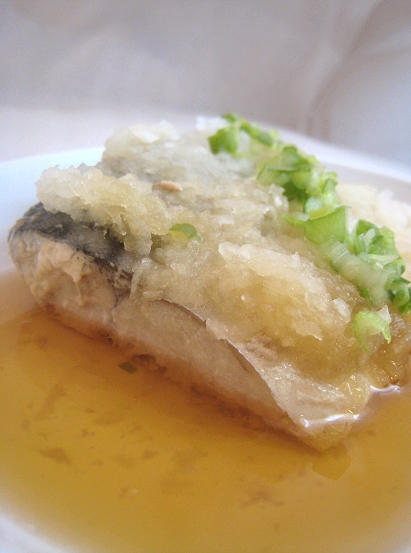
[ts]
All right, this is our Regional Recipes entry. As mentioned before, this is another nimono or simmered dish.
We chose this because we all love saba or any type of mackerel, especially grilled or broiled. Simmering it was a new way to enjoy the fish. Also, thinking of what the rest of the family will actually eat, we saw no hindrance to their enjoyment of daikon, seeing as it's a family favorite in Mama's Ma-Kut (Pork Bone) Soup.
Good thing the saba were already cleaned and in fillets. All I needed to do was cut the fillets in half before starting the cooking portion of the recipe.
[js]
We usually buy our saba frozen (I have not seen it sold fresh) and this one came 5 fillets in one pack.
I was mildly trepidatious seeing the instructions to fry the fish if "absolute freshness" is in question, thinking that would be another step in the seemingly endless list.
Upon opening the packet, I smelled the fish immediately. No off or fishy smell so it was all good. Frying averted.
I don't know about *ABSOLUTE* freshness but these saba fillets were fresh. Perhaps they had been flash-frozen at sea or at least processed quickly and blast-frozen immediately within catching.
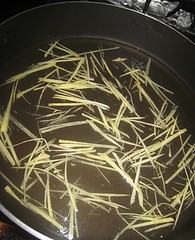
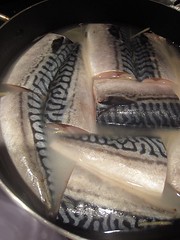
[ts]
Oh, I confess, we didn't have any sake in the house. So to start the dish, I had dashi and ginger "threads" (instead of sake and ginger). Into a wide saucepan they went, then the fish, skin-side up. It was specifically written in the recipe that the fish not overlap.
The liquid was brought to a boil, then reduced to low. I had to use a drop-lid (otoshi-buta) here as well, but the recipe didn't suggest making a vented parchment paper lid. I assume that this was because the weight of the drop-lid was needed, seeing as the recipe stated that the drop-lid was to keep the fish fillets intact.
So, I had my own ghetto version of otoshi-buta.

simmering with ghetto otoshi-buta
[ts]
Yes, it was just a smaller lid inside the bigger pan. ;)
The saba were simmered for 10 minutes.
Then, the rest of the seasonings were added: salt, light soy sauce, mirin and dashi. The saba continued to simmer, this time uncovered.
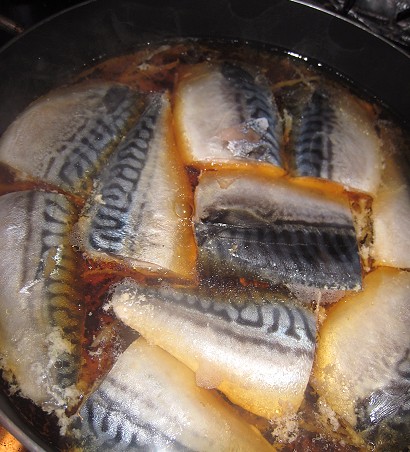
uncovered simmering
[ts]
Meanwhile, we had to prep the radish and green onions.
The green onions just had to be chopped finely. As for the radish, it had to be grated finely.
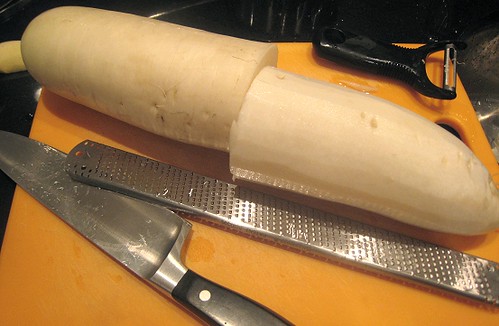
[ts]
I was obsessed about following the recipe exactly, so when it said "finely grated", I reached for the microplane. But that idea was scrapped. Bad, bad idea. The regular grater worked better.

[ts]
See? We reduced that big, honking thing into this pile of wet snow. (We used half of the gigantormous daikon.)
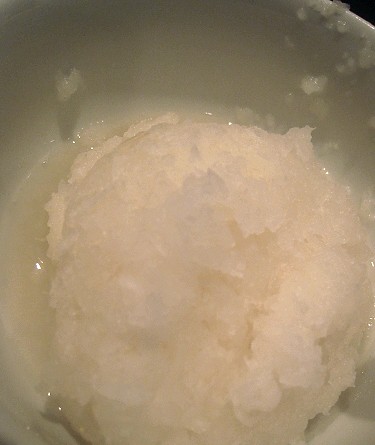
[ts]
It was time for the radish and saba to unite. I tried to spread the radish as nicely as I could on top of the saba pieces. As for the "sprinkling" of the green onions, I had to give up trying to make it "Japanese" as I really had no idea what a "nice" pattern would be.

[ts]
The drop-lid had to be used again, but I was afraid my metal lid would disturb the radish layer. So, I used the vented parchment paper lid from the potato dish.
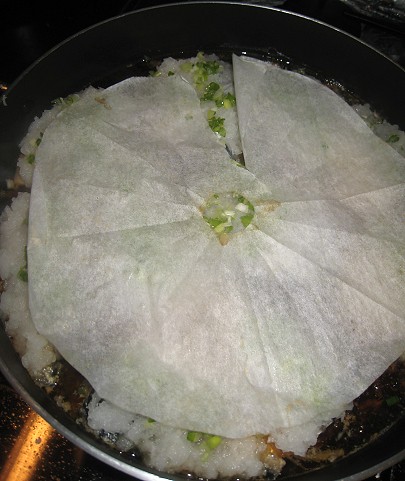
[ts]
The saba just needed a few more minutes of simmering and it was done.
This time, the recipe called for placing each saba piece in individual shallow bowls and spooning the simmering liquid over the top. One is supposed to serve it with seven-spice mixture (shichimi), but we didn't have that. (In fact, I wasn't sure sure what that was. Of course, now I have looked it up.)
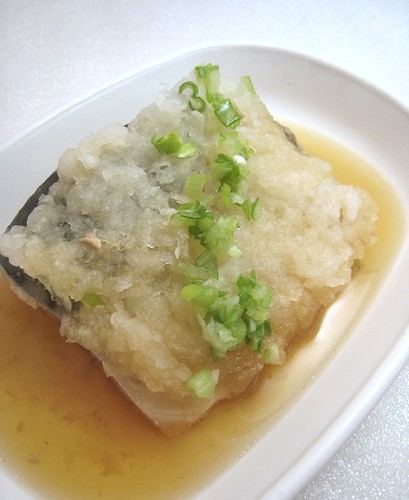
[ts]
Once again, the book stated that one piece was one serving. How can that be? I, myself, wolfed down at least 3 or 4. I think Japanese people may be horrified.
[js]
Saba simmered in this manner seems very different than grilled or broiled saba. Being a big fan of the mackerel's oily, briny fish flesh, I found the saba here more muted, very understated. That is, the fish still tasted like saba, albeit without its usual punchiness.
Um, I think I still prefer the usual way we eat saba, but I like this dish too, if only for a change up some of the time.
I cannot believe how we cut down that big hunka radish to about a cup of snow! Wow.
Usually, grated daikon is also served with broiled or grilled saba, but I am never able to eat it because of its too-radishy pungency. This time though, the dashi-soy-mirin mixture took the edge off and mellowed the radish out. The radish was actually very nice with the fish and it took me this dish to understand why and how they usually complement each other.
Very good, very understated, very Japanese.
As TS has already noted, our appetite is very un-Japanese and half a fillet is really too, too little. ;)
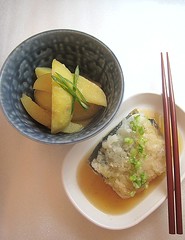
[eatingclub] Japanese
Dashi, Three Types
Potatoes Simmered in Miso (Jaga-imo Miso-ni)
Simmered Saba Mackerel with Daikon Radish (Saba Oroshi-ni)
Miso Soup
Steelhead Trout and Enoki Mushrooms with Wasabi Cream Sauce
Grilled Brats à la Japadog
Warm Wakame Cucumber Salad
Grilled Eggplant with Sweet Miso
-------
RECIPE
Simmered Mackerel with Radish
(Saba Oroshi-ni)
from Japanese Cooking: A Simple Art
6 servings
1 1/2 pounds mackerel fillets, with skin
1 cup sake
3 Tbsp fresh ginger, cut into fine "needle" shreds
1/2 tsp salt
2 Tbsp light soy sauce
2 Tbsp mirin
1 cup dashi
1 1/2 cups finely grated daikon radish
1 Tbsp finely chopped green onion
seven-spice mixture (shichimi)
To prepare:
With tweezers, remove any bones from fillets, then cut 3-inch long pieces. You may lightly fry the fish, dusted in flour, in a scant amount of very hot oil to elimitate any smell if *absolute* freshness is in question.
To cook:
Place sake and ginger in the bottom of a wide saucepan and mix. Lay in the fish, skin side up. THe pieces may touch, but must not overlap. Bring to a boil over high heat, reduce heat to simmer, then cover with a drop-lid (otoshi-buta), which rests directly on top of the fish, to keep fillets intact. Simmer about 10 minutes.
Mix the salt, light soy sauce and mirin with the dashi, pour gently over the fish, and simmer, uncovered, until the broth is reduced 50%.
Spread the grated radish over the fillets and then sprinkle on the chopped green onion. Replace th drop-lid and simmer again for 1-2 minutes.
Carefully transfer the fillets with a spatula to individual shallow serving bowls, taking care that the radish and chopped green onion blanketing the fish do not fall off. Spoon a bit of the sauce from the pan over the top. Serve immediately with a small cellar of seven-spice mixture.
Other mackerel dishes:
Torched! Shime Saba (Japanese Pickled Mackerel)
Grilled Pike Mackerel
Fried Hasa Hasa
Simmered Saba with Daikon Radish (Saba Oroshi-ni)
Broiled Pike Mackerel
We're submitting this to Regional Recipes, a blogging event created by Blazing Hot Wok that celebrates food from all over the world.
 This edition is hosted by Wandering Chopsticks. The region, Japan.
This edition is hosted by Wandering Chopsticks. The region, Japan.Regional Recipes information
Our Regional Recipes posts:
Greek Meatball Soup (Giouvarlakia)
Simmered Saba Mackerel with Daikon Radish (Saba Oroshi-ni)
Thai Fried Chicken
Roast Pork Belly with Puy Lentils
Beef "Ribbon" Kebab (Pasanda Kabab) with Cilantro Chutney
Canadian Onion Soup with Oka Cheese
Muffuletta
Börek with Beef Filling
Korean Pork Bulgogi (with Muu Namul, Kong Namul)
Lobster Congee from a Lobster Feast
Pork Jowl (Pork Cheeks) with Brown Sugar Rub
Beef Salpicao
Cuban Arroz con Salchichas (Yellow Rice with Vienna Sausages)
Cuban Pastelitos de Guayaba y Queso (Guava and Cheese Pastries)
Vietnamese Spring Roll (Cha Gio)
Grilled Fish Fillet on Oregano
Pastéli (Greek Sesame Snaps)
Before anything: when I read the title, my mind went by default to the banana place. Hee hee :)
ReplyDeleteI am totally LOL over your un-Japanese appetites. That's why Japanese women don't get fat! Or maybe because they have such lovely, healthy meals. I'm not sure I'll ever get my hands on a fresh saba mackerel in these parts, though :(
I love how you gave the play by play...this honestly looks good! A ton of steps - geeeez - but it really does look great!
ReplyDelete-DTW
www.everydaycookin.blogspot.com
Congratulations on winning both the Royal Foodie Joust and Ben's What's Baking event. YTou are on a roll...better buy your lottery tickets:D
ReplyDeleteWow, you guys have really been working hard on this dish! It looks wonderful
ReplyDeleteFinally! ;)
ReplyDeleteI used grated daikon on my braised pork and it made it so incredibly tender.
I'm more of a grilled mackerel fan myself but I bet this would be so tender and slightly sweet.
Manggy:
ReplyDeleteHey, saba-banana simmered in dashi and soy sauce could work! =)
We've never seen saba mackerel fresh either, only frozen.
Darius T. Williams:
kat:
With all my poo-pooh-ing about the multiple steps, it's still actually an easy dish. ;D
Bellini Valli:
Thanks! If only, right? =)
Wandering Chopsticks:
Oh, GRATED radish in a braise, eh. We've only ever put it in cubes in braises... or in pork-bone soup. Will try it grated.
And yes, grilled mackerel is the bestest! [drooooool]
Another restaurant creation :)
ReplyDeleteWonderful submission! I love mackerel too. Grilled is good, but have you tried it smoked? I used to eat it like once a week when I lived in DK.
ReplyDeletelove love love all your Japanese creations =D
ReplyDeletelook like alot of work involved to create this healthy and pretty dish! Love saba and sawara but never cook this way.
ReplyDeleteWhat beautiful flavours. I love mackerel but have never made it at home. You put so much work into this dish and it looks great.
ReplyDeleteMy family loves mackarel, too! esp grilled. Gotta try cooking them this way.
ReplyDeleteSeafood soups are so conforting (of course delish) and it seems every culture has their own version.
ReplyDeleteOh how I love this. Thanks for showing the step by step.
ReplyDeleteI'm sure I had this dish (or a very close relation to it!) at a Janapese place near my work recently here in London. I went with a Japanese friend who said they'd order for me and this is what I got - heavenly!! The flavours work so well with the pungent mackerel.
ReplyDeleteLove this recipe.. The serving sizes in that book are so small.. Very Japanese.
ReplyDeleteHi TS - Japanese Cooking is a wonderful book...my Mom had a copy of the original. somehow or someway it got lost....so when the revised edition came out, I made sure to get a copy.
ReplyDeleteYou know Im not knowlagable about a lot of Japenese food , but this looks appealing. I have never heard of Saba fish. Daikon radishes always stare out at me, so I guess I have to but one and play .
ReplyDeletetigerfish:
ReplyDeletenoobcook:
Thanks. =)
Darlene:
You mean, as in smoking the fish ourselves? I must say we've never tried. And, DK = ?
Beachlover:
Oh, what's sawara? Another type of mackerel?
syrie:
Thanks. Try just broiling (or grilling) mackerel... it's too good.
Caroline:
I must say I still like grilled better. But this is a nice change/
Jeanne:
Good! Maybe that means we got this right! =)
Jude:
Haha, yeah... for us, all those servings sizes are SNACK sizes. =D
KirkK:
It's really very good and detailed, especially for someone who doesn't really know much about Japanese food!
glamah16:
I don't know if saba mackerel is called another name or not.
love how these saba fillets look! they look tasty!! I do love Japanese cooking
ReplyDeleteI love your ghetto version! Your step by step instructions are great. I might give it a try and eat the Japanese-sized version!
ReplyDeleteThis looks really good and your instructions make the recipe much less intimidating than might, otherwise, be the case. Thanks for sharing.
ReplyDeleteI'd like to invite you to have a look on a funny home-made decoration - the radish mouse on cold spread.
ReplyDeletehttp://hubschrauber.wordpress.com/2008/12/18/maus-auf-brot-hors-doeuvre/
Best regards from Germany
Rosemarie